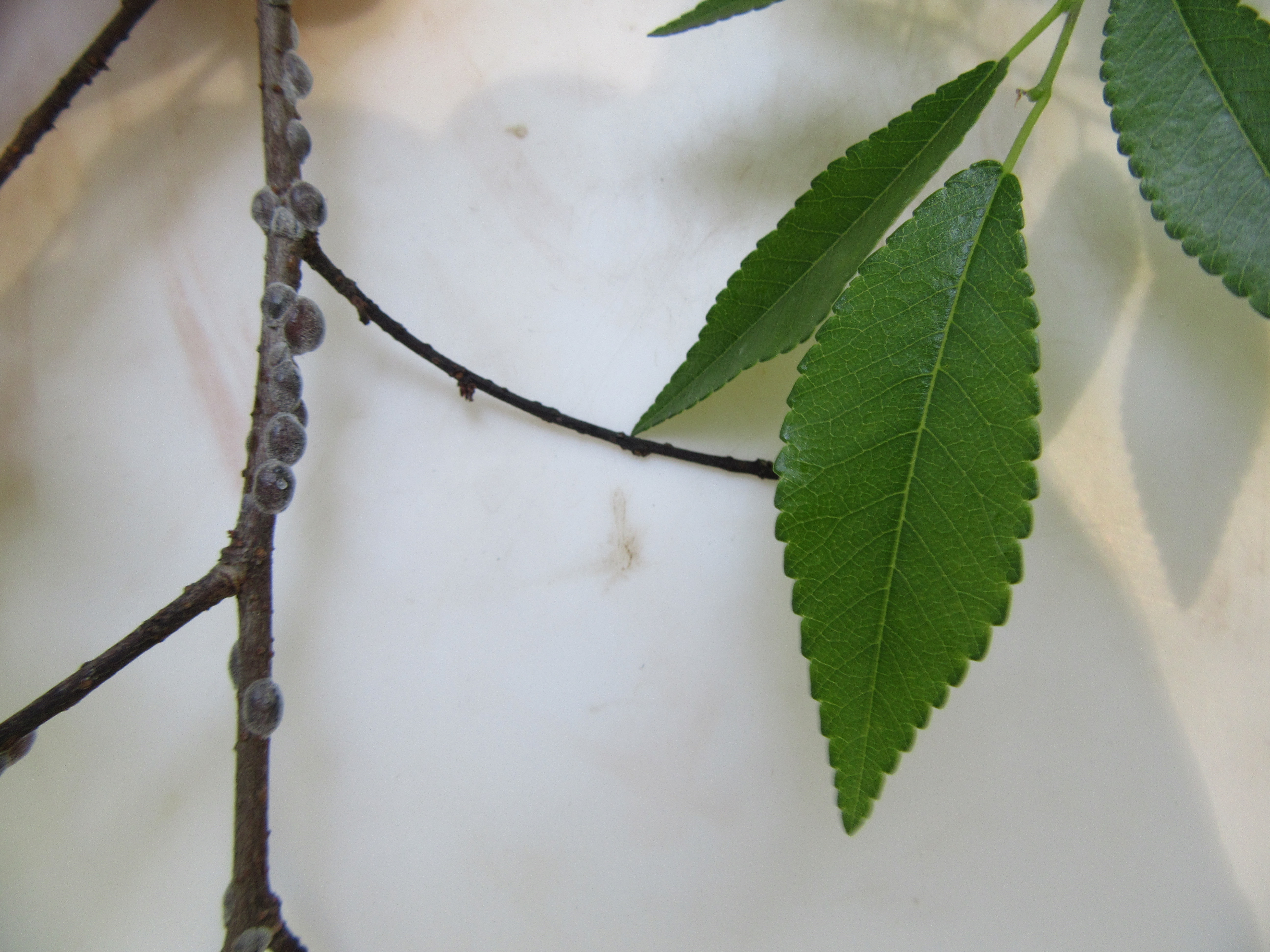
by Matt Lollar | Apr 14, 2016
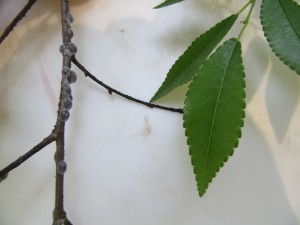
Scales on a Chinese Elm.
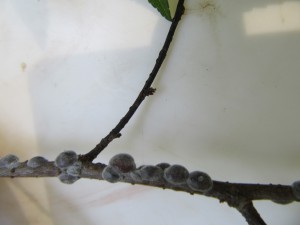
Scales on a Chinese Elm.
Last week as I was basking in the shade of the Chinese Elms (Ulmus parvifolia) in my yard, I noticed some strange lumps on the twigs. Upon further investigation, I realized the “lumps” were scales. Scale insects are serious pests of a number of ornamental plants. Here in Florida there are 13 different families of scales with the most common being armored scales, soft scales, and mealybugs. Scales have piercing-sucking mouthparts which they use to siphon fluids from the leaves, stems, and sometimes roots of many ornamental plants. Heavy infestations cause extensive leaf yellowing, premature leaf drop, branch dieback, and eventually plant death.
Scale Biology
The life cycle of a scale begins with eggs being laid beneath wax coverings or beneath the adult female. Eggs typically hatch in 1 to 3 weeks. The newly hatched nymphs, called crawlers, move around a plant until they find a spot to feed. Once a feeding site is located, their piercing sucking mouthparts are inserted into the plant and the crawlers begin to feed and grow. The males of many scale species develop wings as adults and fly to other plants to reproduce.
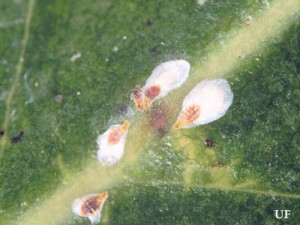
The magnolia white scale. Credits: University of Florida
Armored Scales
Armored scales get their armor by secreting a waxy covering over their bodies that is not attached. The scale lives under this covering and uses it as a protection to feed under. Armored scales can be almost any color or shape and range anywhere from 1/16 to 1/8 inch in diameter. For females, these shapes range from circular to oval to long and slender. The males typically have coverings that are more elongate and smaller than the females. As adults, the males are tiny, winged, gnat-like insects and are rarely seen.
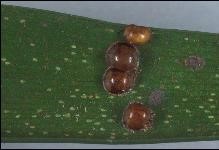
Hemispherical scale on coontie. Credits: Lyle Buss, University of Florida
Soft Scales
Similar to armored scales, soft scales secrete a waxy covering, but it is attached to their bodies. Soft scales can be a number of colors, shapes, and sizes and range anywhere from 1/8 to 1/2 inch in diameter. Their shapes vary from spherical to nearly flat.
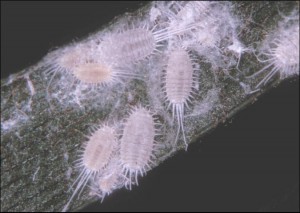
Mealybugs. Credits: James Castner, University of Florida
Mealybugs
Mealybugs are soft-bodied insects that possess a covering of flocculent, white, waxy filaments. They are about 1/8 inch in length and usually pinkish or yellowish in color. Mealybugs have piercing-sucking mouthparts which they use to siphon fluids from the leaves, stems, and sometimes roots of many ornamental plants. Mealybug damage produces discolored, wilted, and deformed leaves.
Scale and Mealybug Management
- Cultural Control – Plant inspection prior to purchase or installation is the first line of defense against a scale or mealybug population. Make sure to inspect the undersides of leaves and plant stems. Infested sections of plants can be pruned and plant material should be cleaned from the planting area and discarded. Also, you can increase air flow and decrease humidity by proper installation and pruning. Over-fertilizing can also increase pest populations.
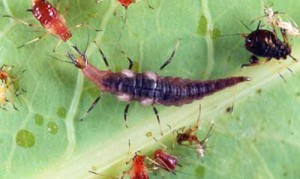
Larva of a brown lacewing. Credits: Lyle Buss, University of Florida.
- Biological Control – Predators, such as ladybugs and green lacewings, are usually present in large enough numbers to suppress scales and mealybugs to a desirable threshold. However, broad-spectrum insecticides and bad weather can reduce predator numbers. Look for signs of predation by inspecting dead scales for jagged holes in their waxy coatings. If predation signs are present, use more selective chemical controls and oils as opposed to broad-spectrum products.
- Chemical Control – Timing is everything when it comes to managing scale and mealybug insects. Crawler activity is more pronounced with the flush of new plant growth in the spring. Before application, prune infested plant parts off first to promote greater penetration of insecticides into the foliage. Contact products (acephate, bifenthrin, carbaryl, etc.) must be applied to inhibit the crawler stages of these insects and systemic products (acetamiprid, imidacloprid, thiamethoxam, etc.) can be used on the sessile growth stage. Plants should be sprayed thoroughly to the point of drip or “run off” from leaves, twigs, and stems. Repeated applications may still be necessary even if the timing is right, as crawler populations are often large and crawlers like to hide under old waxy scales. Systemic drenches are also a viable option. With good spray coverage, horticultural oils can kill scales at all stages of growth. Refer to the product label for phytotoxicity and temperature guidelines. Even after successful treatment, the outer coatings of the scales may remain on the plant material for weeks, which can be unsightly. The best way to determine if scales are dead is to squeeze them. They will be dry when squeezed if they are dead and they will ooze liquids if they are living (they were at least alive to the point of being squashed).
For insect identification and additional information on scale control, please see:
A Guide to Scale Insect Identification
UF/IFAS Featured Creatures
Your County Extension Office
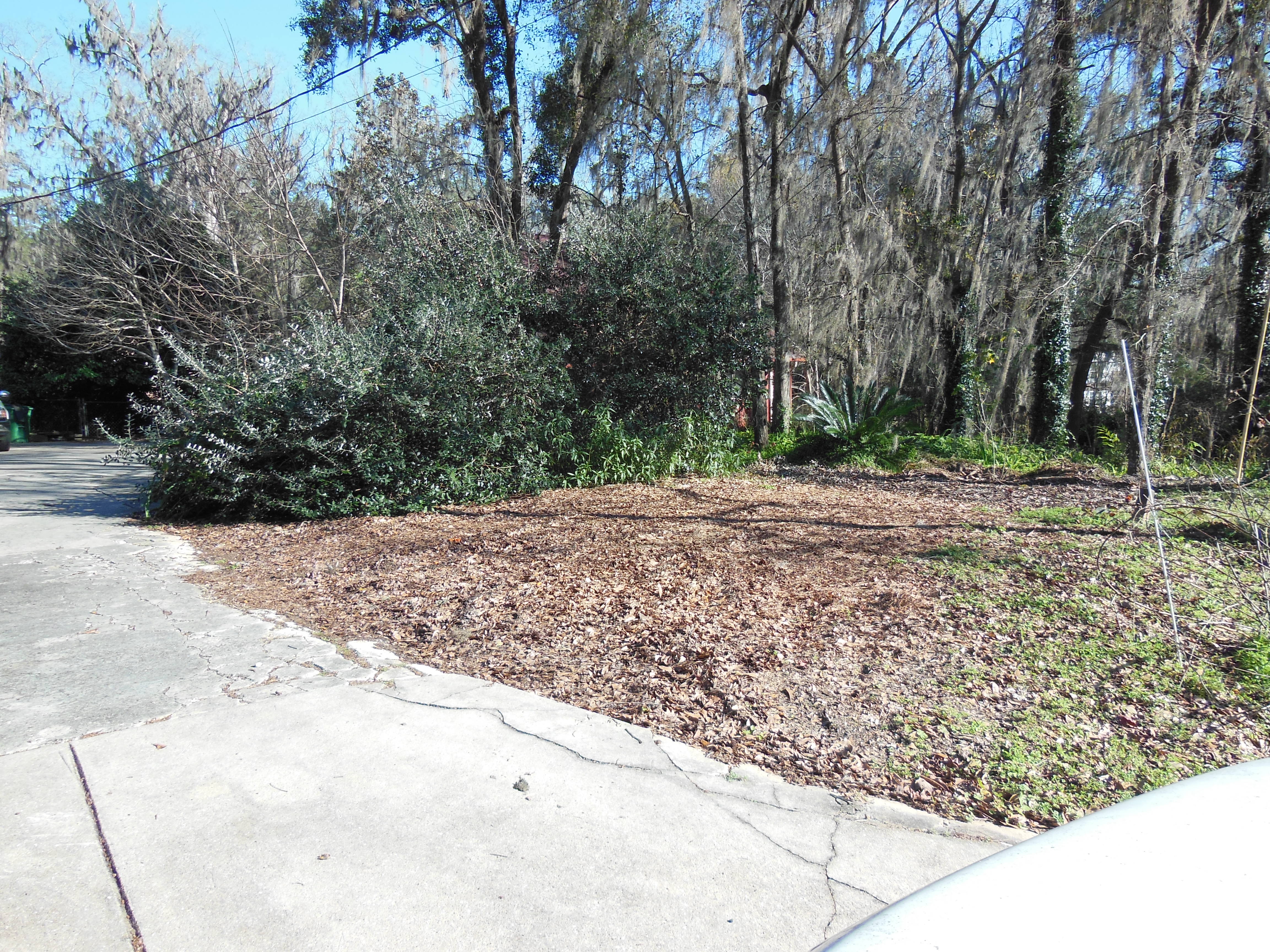
by Mark Tancig | Apr 14, 2016
Do you have a bare spot that you would like to see go away? How about a problem getting something to grow in a particular area? I’m not talking about that receding hairline or bald spot, I’m talking about your lawns and gardens. Many residents have these problems, whether it is too much shade under our beautiful oaks, that stubborn orange clay, or that hot, dry sand. Often times, the best remedy for these situations is to use mulch. Mulch is a versatile tool in the home landscape that provides many benefits while adding aesthetic beauty.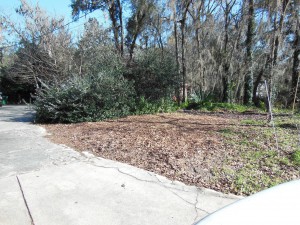
Some of the benefits of using mulch in your landscape include retaining soil moisture, reducing the amount of weeds, insulating the soil (keeps it warm during cold months and cool during the warm season), improving soil health through decomposition, and protecting plants from mower and/or trimmer damage. In addition, mulch can help protect the quality of local lakes and streams by reducing soil erosion and stormwater runoff. Therefore, not only can it improve your yard, but it can also help minimize impacts to our precious natural resources.
When purchasing mulch, there are many options available. Local lawn and garden shops offer many different types of mulch based on their origin (type of wood the mulch comes from), texture (shredded vs. nuggets), color, and, of course, cost. When considering these options, here is some information to help you choose:
- Origin. Cypress mulch comes from the harvesting of natural cypress wetlands and it not recommended by the University of Florida Florida-friendly Landscaping Program. Pine bark mulch is produced from the paper/pulp industry as a marketable byproduct. Pine needle mulch is harvested from pine tree farms as the trees mature to harvestable size.
- Plant Needs. Pine mulch (either bark or needles) can lower the pH of your soils as it breaks down over time. This is great for acid-loving plants such as azaleas, gardenias, and blueberries, but may affect species that require a high pH.
- Texture. The coarser the texture, the longer the mulch will last. Finely shredded mulches breakdown quicker than coarse mulches, such as bark nuggets. As the mulch breaks down, it adds organic content to your soil, thus improving soil health.
If you want to save money, you can often contact local tree trimming companies for their hard day’s work. As they trim or remove trees, the smaller material is shredded into mulch and they are often willing to drop it off in your yard instead of paying for its disposal. It is best to allow this freshly shredded mulch to cure for some time before placing it in your garden beds since freshly shredded mulch can temporarily reduce the availability of nitrogen in the soil.
When using free mulch options, be aware that weed seeds may be present.
Be sure to apply the mulch in a two to three inch layer in your landscape beds or around trees and shrubs. It’s not a bad idea to aerate any old mulch already present to prevent matting or compaction. This can be done with a rake or pitchfork.
So cover up that soil to improve the look and fertility of your landscapes and to reduce erosion and stormwater runoff. If you have any questions about mulch, more information is available at the Florida-Friendly Landscaping website: http://fyn.ifas.ufl.edu.
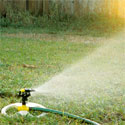
by Larry Williams | Apr 7, 2016

Watering to establish lawn
When watering to establish a lawn or when renovating (redoing, patching, reestablishing, starting over, etc.) a lawn, we normally call for 2-3 “mists” throughout the day for the first 7-10 days until roots get established. These are just 10 minute bursts. Then back off to once a day for about ½ hour for 7-10 days. Then go to 2-3 times a week for about 7 days. By then your lawn should be established.
Of course, if we are experiencing adequate rainfall, you may not need to irrigate. Rain counts. But in the absence of sufficient rain, you’ll need to provide enough water at the correct time to allow your new sod to root – hence, the above directions.
A well designed and correctly installed irrigation system with a controller, operated correctly, really helps to achieve uniform establishment. It can be very difficult or impossible and inconvenient and time consuming to uniformly provide sufficient water to establish a lawn with hose-end sprinklers, especially if the lawn is sizeable and during dry weather. Most people are not going to do the necessary job of pulling hoses around on a regular basis to result in a well established lawn.
There is no substitute or remedy for incorrect irrigation when establishing a brand new lawn or when renovating an entire lawn or areas within a lawn.
It would be wise to not invest the necessary time and money if the new lawn cannot be irrigated correctly. Taking the gamble that adequate (not too much, not too little) rainfall will occur exactly when needed to result in a beautiful, healthy, thick, lush lawn is exactly that – a gamble.
An irrigation system is nothing more than a tool to supplement rainfall. As much as possible, learn to operate the irrigation controller using the “Manual” setting. It is also wise and is state law to have a rain shutoff device installed and operating correctly. The rain shutoff device overrides the controller when it is raining or when sufficient rainfall has occurred. Rain shutoff devices are relatively inexpensive and easily installed. Also, a good rain gauge can be an inexpensive tool to help you monitor how much rain you’ve received. Rain counts.
Too much water will result in rot, diseased roots and diseased seedlings and failure. Too little water will result in the sod, seedlings, sprigs or plugs drying excessively and failure to establish. The end result at best is a poorly established sparse lawn with weeds. Or complete failure.
For additional information on establishing and maintaining a Florida lawn, contact your County UF/IFAS Extension Office or visit http://hort.ufl.edu/yourfloridalawn.
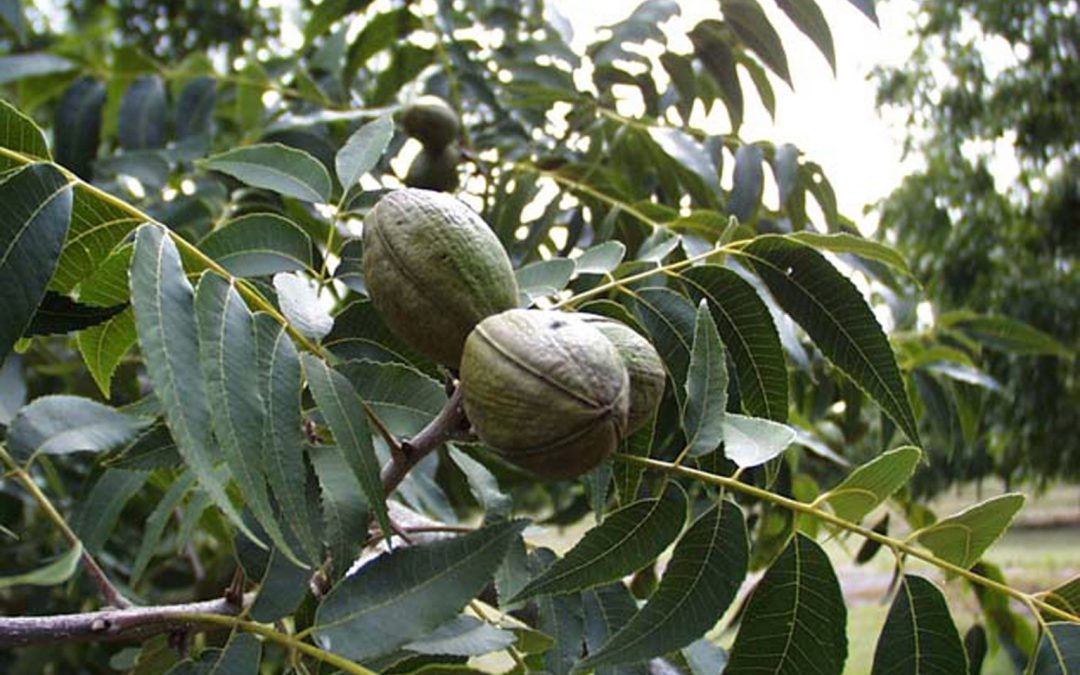
by Larry Williams | Jan 13, 2016
Pecan trees are well adapted to our area, making beautiful large shade trees. And, if the correct varieties are planted, they can provide pecans.
Only those pecan varieties that show some real resistance to disease problems are recommended for planting here in the humid south. Select grafted trees of Desirable, Curtis, Elliott, Moreland or Stuart varieties.

Pecan leaves and fruit. Photo credit: Brad Haire, University of Georgia, Bugwood.org
Obtain and plant your pecan trees during the winter – December through February. Purchase trees that are three to six feet tall. Larger trees are more difficult to transplant.
Give pecan trees plenty of room to grow. The distance between trees should be approximately sixty feet because mature trees are quite large. Commercial producers sometimes use a closer spacing, primarily because they are using varieties that will bear at an earlier age. But most of those varieties do not have good disease resistance and still require pesticide spray at times. Homeowners will not have the needed equipment to spray a large pecan tree and the drift from such sprays would not be desirable around your home, so commercial varieties aren’t recommended for home plantings.
One of the keys to survival of a pecan tree is not allowing the root system to dry out before, during or after transplanting. Regular watering will be required for a period of at least six months or until the young tree is well established. The planting hole should be 18 to 24 inches wide and only as deep as the root system. Spread the roots so they are not matted together. The planting depth is critical. Place at such a depth that the uppermost root is at or near the soil surface. Excessively deep planting can result in eventual death of the tree.
When planting your tree, there is no need or advantage to using peat moss, compost, manure or other organic matter in the planting hole. Plant the tree in the native soil without amendments.
Do not fertilize when the tree is planted. Wait until May of the first year after planning to apply fertilizer.
Remember that pecan trees are large at maturity, with branches spreading 30 feet or so from the trunk. Also, because of the brittle limbs and failing nuts, it’s best not to plant these trees too near the home, driveway or sidewalk.
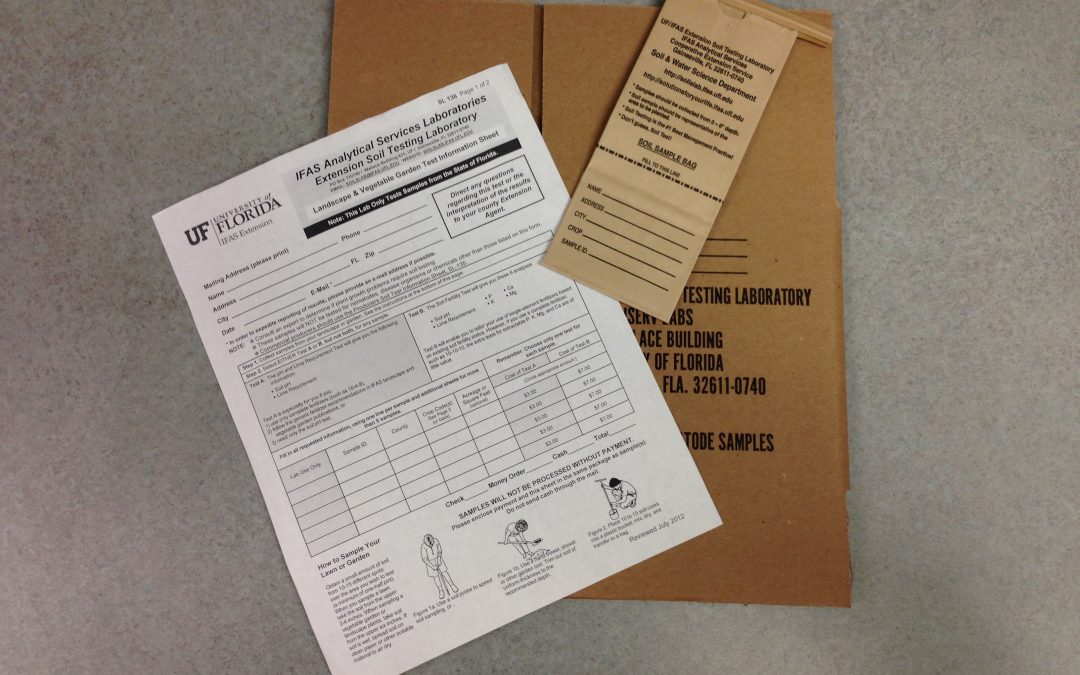
by Beth Bolles | Dec 30, 2015
Information on gardening practices is freely shared between gardeners and many times the good advice is helpful in plant selection and improving plant growth. There are some passed along practices that are not always suitable for every situation and gardeners may need to investigate a little deeper before implementing the good advice.
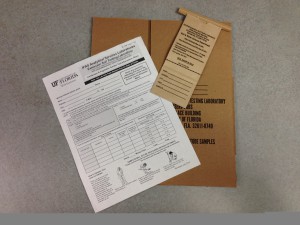
Soil test kit available form your local Extension office. Photo: Mary Derrick, UF/IFAS.
One common recommendation from gardeners is to apply Epsom salts to the soil to improve plant growth. Gardeners may have used Epsom salts for various plants in the garden and viewed plants that appear to grow better or have improved leaf color. Therefore a general recommendation to help others who have some general plant problems or off color leaves is to apply Epsom salts.
Before you apply Epsom salts to your garden, understand that it is an inorganic fertilizer, specifically magnesium sulfate. Plants make their own food but they derive most of their nutrients needed for important functions form the soil. Magnesium is one of the nutrients that is essential in photosynthesis. At times, our sandy soils may be lacking in nutrients but there may be plenty of nutrients available for plants.
The recommendation to apply Epsom salts may sound like a good idea but gardeners should always make sure that magnesium is needed before any applications. Too much magnesium in the soil can interfere with the uptake of other nutrients by plants. You could create more of a problem by indiscriminately applying Epsom salts when magnesium is not needed.
As you hear often from the University of Florida Extension, conduct a soil test before applying fertilizer to determine the major nutrient levels available in your soil. This $7.00 test will help you better manage plant nutrition. If you need assistance interpreting soil test results, contact your local county Extension office.
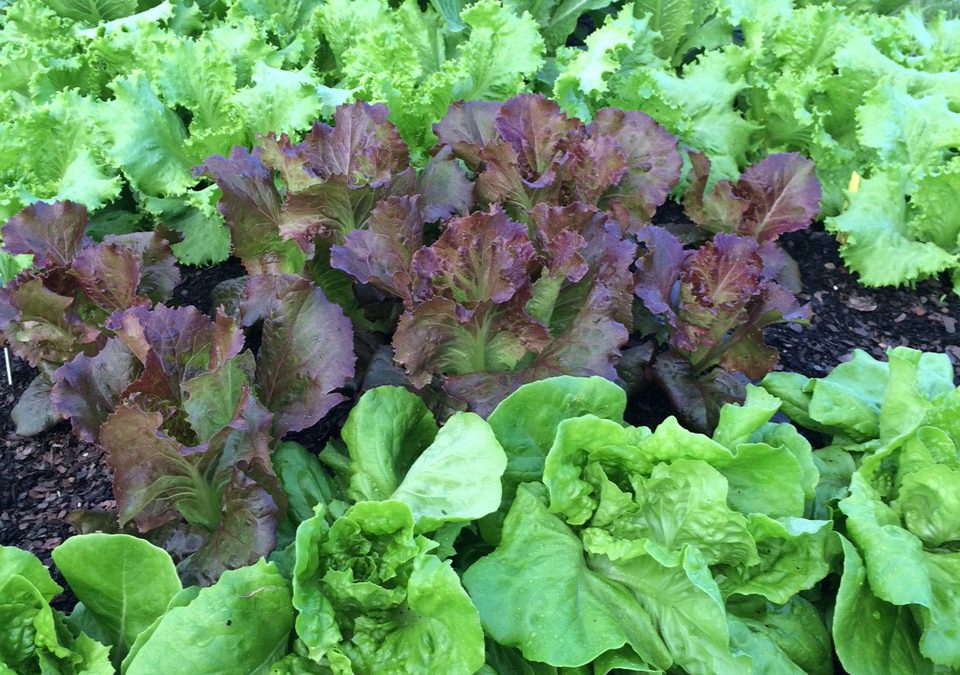
by Molly Jameson | Nov 24, 2015
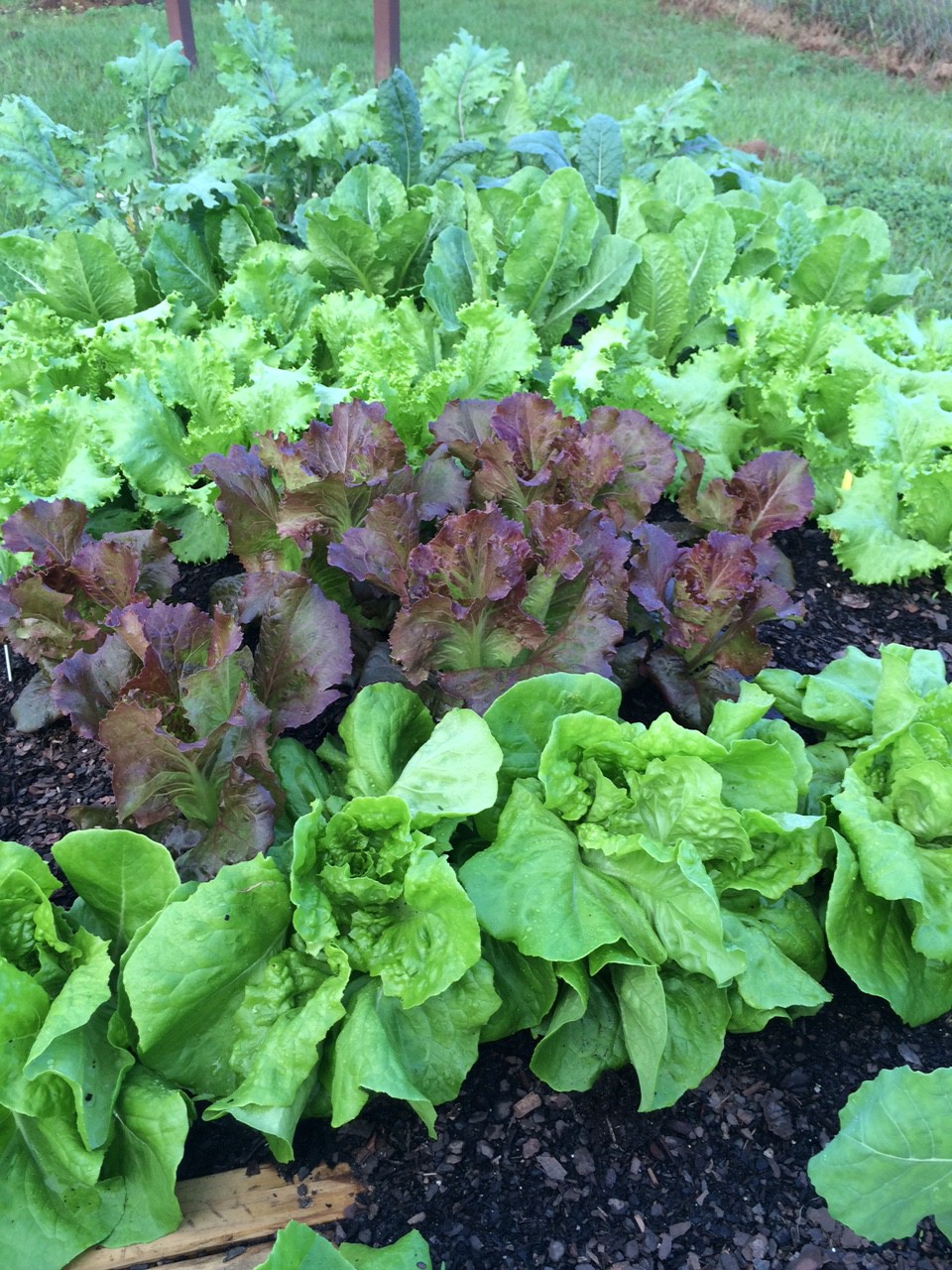
Kale, mustard, and lettuce in fall garden. Photo by Molly Jameson.
In North Florida, December can mark the peak in fall vegetable gardening. Early lettuce varieties are beginning to head and your later varieties are coming on strong. Radishes are starting to erupt out of the ground, and leafy greens are producing big beautiful leaves. But did you know that simple changes in how you harvest can greatly increase the longevity of your fall garden?
Here are a few harvesting tips for stretching out the fall harvest to ensure you will have plenty of greens all the way into spring:

Plant radishes and arugula as gaps form in fall vegetable garden. Photo by Molly Jameson.
- Harvest leaves often: Leafy vegetables and herbs often produce more leaves the more you pick them. Harvest the lower, oldest leaves of vegetables such as leaf lettuce, kale, collards, and Swiss chard often. Be sure to maintain two to three leaves per plant; this method will ensure tender, pest-damage-free leaves, while encouraging the plant to keep producing.
- Thin to eat: Plants such as arugula and spinach are excellent vegetables to seed heavily and thin to eat. Once the plants have produced their first few true leaves, harvest the whole plant and use the leaves in salads. Continue this method until plants are about six inches apart, and then harvest leaves only. In this way, you will have salads filled with small tender leaves in the beginning of the season, and larger leaves for salads and cooking all the way into spring.
- Cut stems of florets high: Once your broccoli or cauliflower curds are ready to be harvested, cutting the stem high will often mean more secondary heads will form. Once your plants quit producing florets, start harvesting the leaves, which have great flavor and are highly nutritious. Also, with cauliflower, loosely tie the leaves around the curd. This forms a protective barrier from the sun and also improves color.
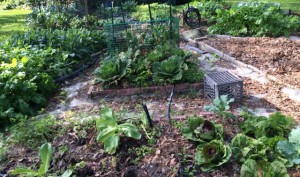
Assorted greens in fall vegetable garden. Photo by Molly Jameson.
- Harvest in the morning: Plant moisture and nutrient content are often highest in the morning. Once harvested, these leaves are less likely to wilt, and flavor will be preserved. Submerge or run cool water over the plants to maintain vigor. Alternatively, you can harvest in the evening if you plan to prepare the food that night.
- Fill in the gaps: Once you begin harvesting frequently, you will notice space begins to open up in your garden. It is often too early to plant cold-sensitive spring crops, yet you can continue to plant some quick growing fall vegetables, such as radishes and arugula. Sow these seeds as space opens up to maximize your food production until it is warm enough for the new season.
- Use materials to extend the season: By using frost cloth, low tunnels, cold frames, and shade cloth, you can protect your vegetables from early cold snaps and extend the season into spring. These materials, as well as wire and netting, can also protect your crop from deer, squirrels, and rabbits.


















